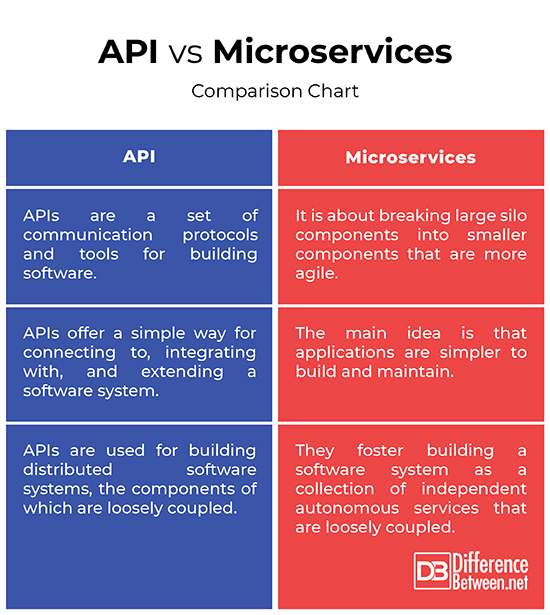Difference Between API and Microservices
It’s quite surprising to see so many common misconceptions around microservices and APIs. For example, microservices are like web services but finer grained or like APIs are microservices. These are all kind of fundamental misconceptions under the covers. We take it upon ourselves to talk about what the key differences are in those two concepts.

What is an API?
API stands for Application Programming Interface. It’s an interface that allows two applications to talk to each other. Software is used by people via a user interface. However, people are not the only ones who use software. Software is also used by other software applications. This requires another type of interface which is called an application programming interface, or in short API. They are like doorways that allow developers to interact with an application. It’s a way of making requests into a component.
In today’s digital economy we typically talk about web APIs that facilitate B2B communication. Web APIs are web services and deliver data resources via a web technology stack. They offer a simple way for connecting to, integrating with, and extending a software system. Particularly, they are used for building distributed software systems, the components of which are loosely coupled. APIs can increase both the usability and exposure of a service. Basically, all applications rely on APIs to function.

What is a Microservice?
Microservices (or microservices architecture) are an architectural and organizational approach to software development where the functionality is broken down into more manageable full decoupled pieces. It’s a distinctive method of developing software systems that is focused on building single-function modules with well-defined interfaces and operations. It is about breaking large silo components into smaller components that are more agile and more able to be changed more easily.
Microservices are an example of Service-Oriented Architecture (SOA) and has become one of the most popular architectural styles in the enterprise software architecture landscape. The microservices architecture fosters building a software system as a collection of independent autonomous services that are loosely coupled. Microservices are a software modularization approach to breaking down large software systems into smaller parts. They are self-contained processes or virtual machines, and they communicate by explicit interfaces.
Difference between API and Microservices
Definition
– APIs are a set of communication protocols and tools for building software. It is a set of pre-defined methods of communication between various components. APIs are like doorways that allow developers to interact with an application. Microservices can be seen as a lightweight service-oriented architecture (SOA) for developing software systems. It divides an application’s different functions into smaller components called services.
Concept
– Microservices (or Microservices architecture) are an architectural and organizational approach to software development which is about breaking large silo components into smaller components that are more agile and more manageable. APIs are the interfaces that can be used to expose the functionality in those components. Particularly, APIs are used for building distributed software systems, the components of which are loosely coupled.
Function
– The two are separate concepts. APIs offer a simple way for connecting to, integrating with, and extending a software system. APIs provide a reusable interface that different applications can connect to easily. However, they are not usually visible on the surface; instead, they operate under the hood and are directly called by other applications. Microservices architecture is usually organized around business capabilities and priorities and is designed to solve problems that are big and complex.
API vs. Microservices: Comparison Chart

Summary
Both APIs and microservices may seem similar to many, but they are very different concepts. And they are not directly related. Those two things are completely independent of one another. That being said, microservices are components that are used to build up an application in a more agile framework. It’s a distinctive method of developing software systems that is focused on building single-function modules with well-defined interfaces and operations. APIs, on the other hand, are a way of exposing the functionality of an application whether it’s written as microservices or not. APIs provide the capabilities which are essential for connecting, extending and integrating software. APIs are basically the frameworks through which developers can interact with a web application.
Can an API be a microservice?
Both concepts are central to application development and design. APIs are a part of web application that communicates with other applications. APIs can increase both the usability and exposure of a service. Microservices architecture is an approach to software modularization that tries to break down an application’s functions into smaller, easy to manage programs.
Is REST API a microservice?
Microservices communicate only via explicit interfaces, which are realized using mechanisms such as messages or REST. Each application is designed as an independent service in microservices architecture. REST APIs are the rules, commands and protocols that integrate the individual microservices, so they function as a single application.
- Difference Between Caucus and Primary - June 18, 2024
- Difference Between PPO and POS - May 30, 2024
- Difference Between RFID and NFC - May 28, 2024
Search DifferenceBetween.net :
Leave a Response
References :
[0]Indrasiri, Kasun and Prabath Siriwardena. Microservices for the Enterprise: Designing, Developing, and Deploying. New York, United States: Apress, 2018. Print
[1]Preibisch, Sascha. API Development: A Practical Guide for Business Implementation Success. New York, United States: Apress, 2018. Print
[2]Wolff, Eberhard. Microservices: Flexible Software Architecture. Massachusetts, United States: Addison-Wesley Professional, 2016. Print
[3]Mitra, Ronnie and Irakli Nadareishvili. Microservices: Up and Running. Massachusetts, United States: O'Reilly Media, 2020. Print
